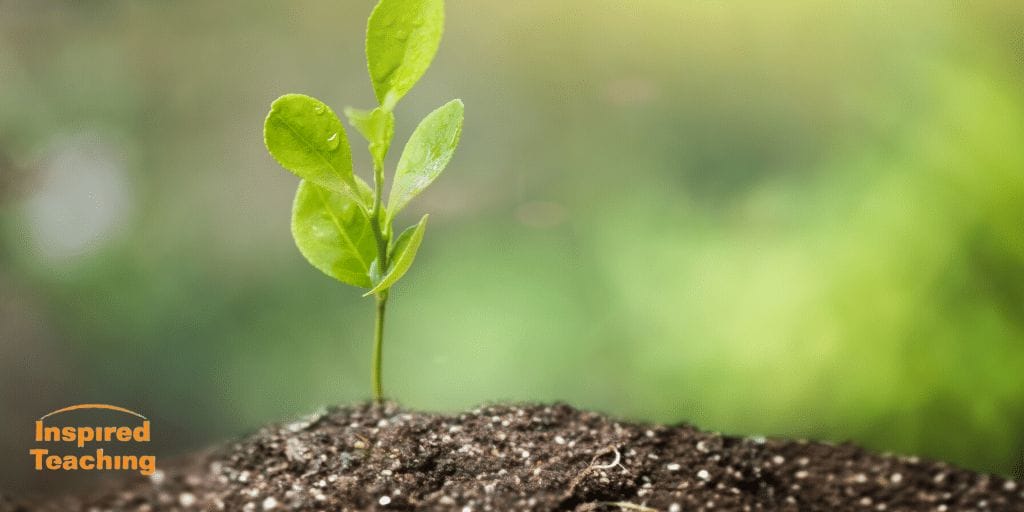The following activity is part of a series we’re creating to support students, teachers, and caregivers, during this unprecedented time. Read more about the project here. If you try this activity with your student(s), we’d love to see what you do. Share your journey via the #Inspired2Learn hashtag on your preferred social platform.
Created by: Aleta Margolis
Discipline: science, writing, math
Age level: elementary through high school
Time: 15 minutes per day, for as many days as you like!
Materials: camera (smartphone or any kind); writing materials; ruler, tape measure or other measuring materials
What to do:
Thanks to the internet, we’ve become accustomed to speeding up time. We can go online and retrieve forgotten information in less than a second, without needing to do the brainwork of trying to retrieve it from memory; we can find the answer to a new question without spending any time wondering what the answer might be; we can send a message to a friend in another location and hear back a moment later, without the experience of waiting and imagining what our friend might have to say in response. Instant access to information has real benefits. But so does experiencing life in real time. In this activity, learners choose something to observe, and collect data over a period of days or weeks on how it changes and grows, and perhaps transforms.
Each student completes the following steps:
- Choose a living thing growing outside that you will focus on for this entire project. It can be a branch of a tree, a flower bud, a log with moss growing on it, a toadstool that has popped up in the grass, even a patch of grass.
- Take a photograph of your living thing. Notice the angle you’ve chosen – are you standing above it, squatting down next to it, looking at it from below? How close or far away are you from the subject of your photo? Notice the time of day.
- Jot down a few observations of your living thing. What colors and textures do you see? What’s the approximate size of your living thing? Or perhaps you’ll want to use a ruler or other measuring device to determine its exact size.
- You will return to photograph your living thing tomorrow at the same time of day (or as close as possible). Make a prediction about what, if anything, will have changed in your living thing by this time tomorrow.
- Upload your photo and write down your findings on the data collection sheet. Here is an example of one that is currently being filled out:

- Each day take another photo of your living thing. Do your best to be consistent in the angle you’ve chosen, the distance from which you take your photo, and the time of day. Jot down your notes and predictions, and add it to the data collection sheet.
- As you record your observations each day, synthesize the information you’ve found, look for patterns, as well as possible causes for the changes you’ve observed.
- Continue this process for at least one week. If possible, keep going for several weeks.
Extensions:
Students may notice that their object grows, blooms, gets larger for a while. If they keep observing for a long enough time, they may also see their object dry up, wither, shrink, and fade. Petals may fall off of flowers; toadstools may get stepped on and fall apart. This project can teach not only about the natural life cycle of plants (and/or fungi) but also about what happens after they complete the cycle, how a decaying log can support the growth of moss or of a toadstool, how some flowers come back each year, while some don’t.
Consider building on this activity by asking students to write up their findings and share their analysis, each week, or after several weeks, or at any time. Also consider creative writing extensions – for instance, if a student discovers one day that their flower has been trampled, the student can create a story about what might have happened to the flower; imagine which other entities (human, and other species) might come in contact with the natural object and create a story, etc., etc.
You can repeat this exercise with different criteria based on your instructional goal. For instance, if you want to focus on using geometry to infer the dimensions of items out of reach, you might require students to choose an object that’s far away – a branch at the top of a tall tree, for instance. Challenge them to figure out how long it is using geometric principles, since they can’t climb up and measure the branch with a ruler or tape measure.
Inspired Teaching connection:
As students observe their living things, make predictions about what will happen the next day, and return to find out, they are engaging in the Wonder-Experiment-Learn Cycle. While the Core Element Purpose, Persistence, and Action generally refers to students engaging in productive struggle to puzzle through a problem, in this case it refers to the patience students must exercise in order to navigate through this activity. And in this age of instant information/gratification, our patience can surely use some exercise!
See our instructional model here.


